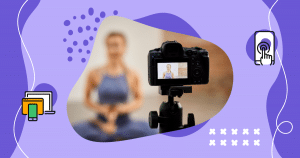Sports connect many of us. We wear the same hats, shirts, and of course, connect digitally to our favorite teams and players. And while audiences continue to be broken up with the addition of more and more digital channels, this also allows sports teams around the globe to reach their die hard fans, as well as the casual ones, in new ways.
“The biggest change I’ve seen for teams is their willingness to post original content intended solely for the digital space,” said Anthony Herron, a former college football star, NFL player, and current TV personality. “It’s become an industry norm for teams to use players and coaches for videos that tell stories their consumers will enjoy.”
Of course, video production – just like all content creation, curation, and responding to user generated content – takes time. That’s why planning is so important. With video content also comes plenty of opportunities to repurpose and use the popular ‘Create Once, Publish Everywhere’ model, aka COPE.

“This has greatly impacted the brand identity for individuals within organizations,” Herron said. “Instead of team personnel seeming like unreachable stars, this targeted content on digital platforms allows fans to feel closer to them. It enhances the emotional investment for viewers.”
Things have changed from the late 1990s when Anthony and I were teammates on the University of Iowa Big 10 team. He’s stayed close to the game as a TV personality while I’m in the digital space of digital marketing strategy today.
That also brings us to Step 1 in our seven-step process. The planning and organization of content ideas, productions and then distribution is more important than ever.
Related: Catch me at the 2017 Digital Sports & Entertainment Summit in Berlin to talk about our process and to answer questions!
Step 1: Plan efficiently
Good planning comes down to being efficient, using the right tools, and:
- Knowing our audiences (aka personas). Even sports teams can have several! A generic “Fan” for example isn’t the only one.
- Tying content to a business goal – without overthinking it
- Knowing what channels to use
- Atomizing content effectively to run COPE efficiently.

Contact me to get an overview of our planning software that ties strategy, planning, and channels together.
The German Bundesliga Club Bayer Leverkusen did this perfectly during training camp in Orlando. The team, of course, knows what its fans want and executed on a number of strategies:
- Live blog covering the team’s activities during their training camp in Orlando, FL
- Microsite built by Rock Content with design by a partner agency
- Content in German, English & Spanish
- Daily blogs in stream format
- Player profiles and team schedules using Rock Content articles
- Brand promotion focused on their team and main sponsor Bayer AG in North & South America
Related: Check out my personal blog post on why I’m so excited to talk about sports content!
Step 2: Monitor
Step 2 to participating in fan and other discussions is to monitor what people are saying. This can get quite overwhelming and I typically recommend the following kind of prioritization:
- Monitor official tags first
- If somebody tags your official presence on a network, try to respond!
- Monitor the key networks
- If your fans are highly active on Twitter, spend time there. If it’s Facebook, focus more time there. If it’s forums, focus there. You get the picture.
- Always use web alerts!
Step 3: Sharing!
To own and participate in the conversation, I would also recommend sharing other people’s content. They’ll appreciate it and feel even more connected to the team. This of course is also the reason why those hashtag pictures at major and minor league baseball games are so popular.
“Send us your pictures via our hashtag on Instagram or Twitter and we might show it on the big screen in the stadium.” Then people take pictures of their picture on the big screen. Those get shared again! See, it’s a great way to connect with our fans!
I remember way back when I was tweeting at a local TV station with a question for the professional football team’s coach. They read it on air! How cool.
Sharing fan comments, questions, selfies, you name it – anything really that shares your club’s fan stories and connectedness – can help.
Step 4: Continuing to grow your audience
There are so many ways to grow your audience, and certainly some of the ways that have existed for decades still exist today:
- If your parents like a team, you might like it too!
- You follow the team your friends follow.
- By geography
- By being good. Think of how many people follow the New York Yankees or New England Patriots or Bavaria Munich – just because they are good. It can go the other way, too. Some people root for the underdog just because they are the underdog and they like that story.
Just by following our steps on here, teams should be able to connect with more of the casual fans and broaden the digital footprint. In addition, I shared some examples of content marketing audience growth strategies for media companies in another blog post. And while that article is indeed written for media companies, many – if not all – of these techniques can also be used by sports teams.
Many content marketing practitioners have used some mix of those strategies to grow their audiences from basically Zero to substantial. Sports teams can do the same.
Of course, like anything in digital engagement, be sure to test, test, test. Do more of what works and less of what doesn’t. And remember that digital marketing is also a bit about riding the current waves of what’s working!
Step 5: Host and optimize the experience
The mix between hosting, participating, and optimizing the experience around the conversation can be a tricky one. On one hand, go to where the fans are. If they are on Twitter, engage with them there. If they are on Facebook, go there, and who knows what new social channel will pop up next.
So let’s not forget about going to those places as necessary. That’s Part 1 in optimizing the experience. ‘We come to you’ is a great relationship-building statement.
Now, I don’t even know any digital engagement teams who aren’t overworked to begin with. Who has extra time in their days, ever? I know I usually don’t either. So we need to prioritize where we spend our time. I would recommend spending some time on those external networks. Even just 15 minutes can do the trick. Can we respond to all or share all? No, but that’s not the objective anyway.
I remember the VP of Social Media at McDonald’s saying at a conference a few years ago that McDonald’s gets mentioned like every second globally. With a team of seven or so based near Chicago it wasn’t feasible to respond to all. The team – at that time – responded to as many as possible.
The UFC’s example of Dublin Fight Night is a great example of tying it all together. Using a microsite, they published pre-produced content at the right times and fed in fan reactions from other social media networks.
Build a site like the UFC’s when the scenario is right. Then determine how it can help you connect with fans you aren’t currently reaching using a variety of networks.
BOOK time with me here to discuss strategies for your next initiative!
Step 6: Skills and talent management
Just about anything in digital engagement comes back to the right strategy, the right players, and the right supporting tools.
It’s important to have a high-level plan and be prepared. Think of the UFC example, where the team was able to pre-produce certain content – like bios and quotes for example – and push them out at the right times.
This of course is similar to the journalistic sports writer model where the writer drafts their article as a game is still going on. Many times they can have something close to done as the game ends. Hit publish. Here it is, readers. Moments after the game! Then it gets updated. Every once in awhile that doesn’t work if the game shifts at the end, but often the planning, practice and knowledge of workflows works. Same for digital sports club engagement teams. You can prepare some things, update them as things change, and keep publishing and responding to fans.
Be sure you have a clear understanding of roles. Too many slashes of responsibilities don’t work long-term. Direct team members toward their strengths. If somebody is really good with video, have them work more on video. If somebody is really good at getting great and unusual stories, figure out a way to leverage that.
Usually in a live event we need a base of these roles and often more:
- Producer – they publish
- Content creator – they create the live content
- Listener – they see what people are saying and play it back to the team
- Decision maker – they can make decision on strategy on the fly
- Other
That’s certainly a very simply way of putting the setup and many teams need multiple versions of these base roles. And then we want to think about our strengths.
As the late Steve Buttry, a long-time journalism thought leader, would say: “Do what you do best and link to the rest.”
In the case of content marketing or digital marketing teams, I like to change that to: “Focus on what you are best at and outsource the rest.” Our Visually community is a great place to find help for infographics and other content creation pieces you might not want or be able to focus on in-house.
Step 7: Measurement and refine
Finally, be sure to set goals and measure what is and isn’t working. Measurements can vary by organization and truly depend on what your goals are! If you’re trying to reach more fans online then reach might be one good goal.
- Determine what your goal is.
- Set measurable metrics for that goal.
- Make a plan with action steps.
- Go.
- Adjust/refine.
This could even be on a project or event basis, but being clear about goals and how to reach them can actually help us get there and figure out why something didn’t work.
Sports play an important part in many of our lives and so does digital engagement. Teams who can do both well can grow their digital footprint, which of course also impacts our offline footprint. Seven steps can sound like a lot, but once we get going, we can run through them quickly. Many teams out there are already following a model like this or a related model.
What’s next?
You know things will continue to evolve. For example, I just recently saw that Nike will now tie jerseys to interactive content. Twenty years ago when I was playing football at the University of Iowa, some of the interactive content and engagement that’s possible today would have seemed unreal. So I’m sure innovations will happen and things will continue to evolve.
Book a free 30-minute content strategy session:

![[ROCK NA] [EBOOK SEO] Complete Guide](https://rockcontent.com/wp-content/uploads/2024/06/banner_Search-Engine-Optimization.png)






